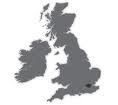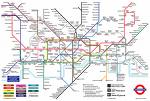
William Marshall (1219)
(RCHM no 10) |

Gilbert Marshal (1241)
(RCHM no 9) |
|
The Military Effigies
The Temple Church lies between
Fleet Street and the Thames Embankment in a complex of
buildings of the legal profession. Some of the entrances to this complex may be
closed at certain times so it is best to check The Temple
Church website
for further details and for a useful plan
of the area. This website also gives details of the
opening hours.
The Temple
Church belongs to two of the four Inns of Court, the
Inner Temple and Middle Temple; it is thus the lawyers'
private chapel. It is extra diocesan, has no parish and
is not subject to the authority of the Bishop of London.
The Temple takes its name from the crusading Order of
Knights Templars founded in 1118 to protect pilgrims
travelling to the Holy Land. Their names comes from
their headquarters being near the site of the Temple in
Jerusalem. Henry I introduced them to England and they
first settled in Holborn near the top of Chancery Lane.
In the 12th century they built their great house of the
New Temple on the banks of the Thames. The Round Church
was built on the model of the Church of the Holy
Sepulchre in Jerusalem. The Order was accused of heresy
and other offences and dissolved in 1312 at the
instigation of Phillipe Le Bel of France. The Grand
Master - Jacques Molay - was burned at the stake. In England
the Templars' property passed to their rival order, the
Knights Hospitallers who, in turn, were suppressed at
the Reformation. Thus the Temple eventually passed to
the Crown, subject to the tenancies of the lawyers who
had settled there as tenants of the Hospitallers and
formed themselves into two societies, The Benchers of
the Inner Temple and the Middle Temple, who secured the
freehold by charter from James l in 1608. One of the
conditions of the grant was that they were to maintain
the Temple Church and its services for ever. The
Minister of the Temple Church is still called the
"Master of the Temple"; the Minister's title
is 'Reverend and Valiant', reflecting the ancient
origin of the church.
In the round part of the church,
simply called The Round, are the nine military
effigies which probably do not represent Knights
Templars but rather their supporters, some of whom may
have actually joined the order shortly before they
died while others became 'associate' members. The
southern group (on your left) includes the effigy of
William Marshal, Earl of Pembroke, who
was Regent during the minority of Henry III, (1219), and
his sons William and Gilbert as well as
that of William de Ros, which was
brought from Yorkshire. In the southern group (on your
right) is the effigy of Geoffrey de Mandeville,
Earl of Essex (1144) and a 13th century coped
Purbeck marble coffin lid. These monuments were restored
by Edward Richardson whose efforts
were much criticised, in the early 1840's,; his drawings of the effigies -
after his restorations -
appear on this page. He also rearranged the position of
the effigies to that we see today; before this they
were arranged in line across the Round, being
centrally divided onto two groups. It is not known
how they were positioned in medieval times.
On the night of 10th May 1941
London was subjected to a Luftwaffe bombing raid and the
roof of the church fell onto the effigies; they had been
protected in the anticipation of such a raid by railway
sleepers but this was a fire bomb so each effigy was
subjected to its own inferno causing great damage,
molten lead from the roof entering cracks in the
stonework. The
effigies have been carefully repaired by Harold Haysom.
Below are photographs of the effigies as well as
other monuments in the Temple Church. As can be seen
the monuments on the north were more badly damaged
than those on the south of the round; those in the
nave escaped damage. To see what the monuments used
to look like before the bomb damage, visit the Cast
Courts in the Victoria and Albert Museum, where
plaster casts of these monuments before damage, as
well as many others, are displayed.
|
|

Geoffrey de Mandeville (1144)
(RCHM no 6) |

Unknown
(RCHM no 5) |

William Marshall II (1231)
(RCHM no 8) |

Unknown
(RCHM no 7) |
|
|

Unknown
(RCHM no 4)
|

Unknown
(RCHM no 3) |

William de Ros (1316)
(RCHM no 12) |
|
|

Richard of Hastings (?)
(c.1185)
(RCHM no 11) |
Although I have given possible
indentification of several of these monuments, it must
be pointed out that there is no firm evidence to identify any
of them conclusively. This is discussed by Philip
Lankester and David Park in The Temple Church in
London (ed. Robin Griffith-Jones and David Park),
Boydell Press 2010. |
Northern Group
On the right above |
 |
 |

Effigy of Purbeck marble in low
relief and probably the earliest of the group. (RCHM no
5) |

Unknown Purbeck marble effigy.
(RCHM no 4)
|
 |
 |
 |
 |
 |

Unknown Purbeck marble effigy (RCHM
no 3) |
| |
|

This Purbeck marble grave cover is
the earliest monument inside the church and is said to
be that of Richard of Hastings (c. 1185),
Master of the Temple who was responsible for the
building of the New Temple. The ram's head decoration
(seen best in Richardson's drawing above) is the symbol
of the Masters of the Temple in London. (RCHM no 11) |
Southern Group
On the left above |

Unknown effigy of Purbeck marble
(RCHM no 7) |
 |
 |
 |
 |
 |
 |
William de
Ros (1316) This effigy was brought from
Kirkham Priory, near York, by Mr Serjeant Belwood,
Recorder of York, about 1682, although why and how this
was done I have not discovered |
| Plaster Casts in the
Victoria & Albert Museum |
| Plaster casts were made of several
of the Temple Church effigies well before the bomb
damage and these give an idea of what these effigies
looked like in the round before this damage. They are to
be found in the Casts Courts in the Victoria and Albert
Museum, together
with many other monuments and effigies, which will be
recorded in due course on other pages. These casts were
taken by Richardson (see above)
after his restoration
work. |
 |
 |
|
Bishop Sylvester of
Carlisle (1255), Purbeck Marble and very well
carved. (RCHM No 1) |
 |
 |
 |
|
Richard Martin (1615)
Recorder of London. He kneels before his desk holding an
open book. By William Cure II |
George Wylde (1679)
signed by William Stanton |
Thomas Lake |
 |
 |
| Sir John Williams (1668) |
Sir John Witham (1689)
signed by Thomas Cartwright Snr |
| Other monuments: |
Edmund Plowden (1584),
Treasurer of the Middle Temple. Alabaster effigy with
richly decorated canopy.
Edward Littleton (1664),
heraldic brass with 29 shields and a Latin inscription
of a winding scroll in front of choir stalls.
John Selden (1654)
Middle Temple jurist, legal antiquary and scholar;
ledgerstone beneath a glass panel.
Lord Chancellor Thurloe
(1806) bust by
Carlo Rossi
|
Other Burials in the
Temple Church
|
St Hugh of Lincoln (1200)
Entrail burial only in the Old Temple, where he died,
although
his body was taken to Lincoln. This was after the move
(in 1161) to the new and present site.
Constant de Hoverio Now lost. Probably
refers to a slab with a lost brass indent, recorded in
an engraving of 1819. Possibly a Templar of c. 1300
William (1256 or 59) Fifth son of Henry
III. A skeleton of an infant was found when the tomb of
Bishop Sylvester was opened in 1810 and said to be of
this William.
Aimery of St Maur (1219)
Robert de Ros (1226/27)
Robert de Vieuxpont (1227/28)
These burials were recorded in various
documents, although the sites are either given obscurely
or not at all. The actual monuments were not described
and some of those above may well relate to these
burials.
|
Please note: this section on the Temple Church is in
progress and further and replacement photographs and information
will be added in due course.
|
|
|

|

|

|

|

|
| Sir John Radclif
(1568) This is a fragment of a
recumbent effigy |
Lady Radclif (1585)
The kneeling figure only |
Peter Cappone (1582)
A
Florentine merchant. Kneeling figure in
surround.
|
Sir James Deane (1608) A
tripartite piece with kneeling figures of Sir
James and his three wives.
|
Andrew (1610), Alderman,
and Paul Bayning (1616),
Alderman and Sheriff. Kneeling figures
surrounding a corner. Attrib. to
Christopher Kingsfield
|
|

|

|

|

|

|
|
Mrs Elisabeth Pepys
(1669) - wife of the diarist. By
John Bushnell
|
Sir Andrew Riccard (1672)
in Roman dress; erected by Levant Company of
which he was chairman. Attrib. to
Bushnell
|
Elizabeth Gore (1698)
- one
month short of her 19th birthday
|
Jane Humberstone
(1694) The monument was erected by her
husband Matthew (1709) whose
name is added at the bottom
|
Samuel Pepys (1703 )- the
diarist. By Blomfield (1884)
|
|
Lord
Mayor Sir Richard Haddon (1524) Brass
with kneeling figures of two wives and five
children.
Thomas Morley
(1566) Brass - a palimpsest
Also several brasses of
the 17th century
Sir William
Ogborne (1734) Master Carpenter to
Board of Ordnance. Cartouche.
|
Top of Page
|
|
|
|

|

|

|

|
|
Richard Chiswell (1711)
'Citizen and Stationer of London' Also his
parentsJohn and Margaret - his
first wife Sarah, and his five
children, who died young, whom he had with his
second wife Mary; she is buried
in 'Christ Church, London.' Attrib. to
William Woodman Snr
|
|
Sir John Micklethwaite (1682)
Attrib. to Gibbons
|
Dame Anne Packington (1563)
The three kneeling figures, shield and
inscription are not 'brasses' but incised and
painted to look like a brass.
|
| Many other
monuments not yet shown. |
|
 |
St
Bartholomew the Great
West Smithfield |
 |
Underground:
Barbican: Circle, Hammersmith and City
& Metropolitan Lines
Hours: Mon-Fri. 8.30am-5.00pm (11th Nov-14th Feb
4.00pm). Sat 10.30am-4.00pm. Sun 8.30am-8.00pm.
There is a charge for visitors of £4.00 (adults)
but not for the 1st hour or those wishing to
worship.
http://www.greatstbarts.com/ |
|
|

|

|

|

|
|
Rahere (1144)Founder of the
church. Made when the east end was modified in
c. 1405. Effigy, in Augustinian habit, of
Reigate stone. Two bedesmen and angel holding
shield at feet. Back wall is pierced to the
ambulatory
|
Edward Cooke (1652)
Attributed to Thomas Burman
|
Percival Smalpace (1558 & Wife (1588)
Below the busts is a slate panel incised with
images of the couple's naked corpses. Attrib to
Giles de Witt
|
John (1681) & Margaret (1680) Whiting
'lived lovingly in holy Wedlock in this Parish
40 years and upwards...'
|
|
 |
St Batholomew
the Less
St Batholomew's
Hospital |
 |
Underground:
Barbican:
Circle, Hammersmith and City & Metropolitan
Lines
Hours: 7.00am - 8.00 pm or later
Website of the Friends
(if you click on this
link, click 'cancel' when the box shows) |
|
|

|
|
William Markeby (1439) & Wife
|
|
top
Click
here for St Paul's Cathedral
|

